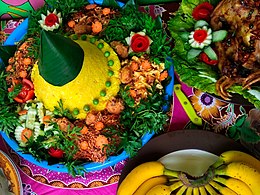 Authentic Minangkabau (Padang), Indonesia, beef rendang has a dark colour, with very little liquid content. | |
| Alternative names | Randang (in Minangkabau) |
|---|---|
| Course | Main course |
| Place of origin | Indonesia[1][2] |
| Region or state | West Sumatra[3] |
| Associated cuisine | Indonesia,[4] Malaysia, Singapore, Brunei |
| Serving temperature | Hot or room temperature |
| Main ingredients | Meat (beef, lamb or goat), coconut milk, chilli, ginger, galangal, turmeric, lemongrass, garlic, shallot |
| Variations | Chicken rendang, duck rendang, liver rendang, spleen rendang |
 |
| This article is part of the series on |
| Indonesian cuisine Masakan Indonesia |
|---|
|
|
Rendang is an Indonesian spicy meat dish originating from the Minangkabau region in West Sumatra, Indonesia.[5] It has spread across Indonesia to the cuisines of neighbouring Southeast Asian countries such as Malaysia, Singapore, Brunei and the Philippines.[2] Rendang is often described as a rich Southeast Asian curry that's made by stewing meat in coconut milk and spices until it becomes tender.[6] Rendang is a piece of meat — most commonly beef (rendang daging) — that has been slow cooked and braised in a coconut milk and spice mixture,[7][8] well until the liquids evaporate and the meat turns dark brown and tender, becoming caramelized and infused with rich spices.
As the signature dish of Minangkabau culture, rendang is traditionally served at ceremonial occasions to honour guests during festive events; such as wedding feasts and Hari Raya (Eid al-Fitr).[9] Rendang is also traditionally served among the Malay community in Indonesia, Malaysia, Singapore and Brunei, as well as the Maranao in the Philippines.[10] Although culinary experts often describe rendang as a curry,[5] the dish is usually not considered as such in Indonesia or Malaysia since it is richer and contains less liquid than is normal for curries.[11]
In Indonesia, 6 traditions of rendang has been recognised as intangible cultural heritage by the Indonesian Ministry of Education and Culture, all are registered under West Sumatra province. They are randang (Minang spelling),[12] and gulai rendang,[13] both appointed in 2010. Randang daging (meat rendang),[14] randang kantang (potato rendang),[15] and randang incek kacang,[16] those three appointed in 2016. While rendang paku (fern rendang) of Dharmasraya, appointed in 2018.[17]
In 2011, an online poll of 35,000 people by CNN International nominated beef rendang as the No. 1 World's most delicious dish in their World's 50 most delicious foods: Readers' picks list (even though it was #11 on the original list produced by the staff).[18][19] In 2018, rendang was officially recognised as being one of the 5 national dishes of Indonesia; the others are soto, sate, nasi goreng, and gado-gado.[20]
- ^ Keating, Sarah (11 June 2018). "How an outrage over crispy chicken united South-East Asia". www.bbc.com. Retrieved 11 October 2020.
- ^ a b Taylor, Jean Gelman (2003). Indonesia: Peoples and Histories. New Haven and London: Yale University Press. pp. 46. ISBN 0-300-10518-5.
- ^ "Should chicken in rendang curry be crispy? Masterchef U.K. sparks debate". Canoe. Associated Press. 3 April 2018. Archived from the original on 5 April 2018. Retrieved 5 April 2018.
The curry (rendang), which originates from West Sumatra in Indonesia, is popular in Malaysia, Indonesia, Singapore, Brunei and southern Thailand.
- ^ Gita Amanda (5 July 2020). "Antropolog: Rendang Bukan Cuma Makanan Tapi Identitas Budaya". www.republika.com (in Indonesian). Retrieved 18 October 2020.
- ^ a b Owen, Sri (1993). The Rice Book. Doubleday. ISBN 0-7112-2260-6.
- ^ "Malaysians roast MasterChef over chicken rendang elimination". BBC News. 3 April 2018. Retrieved 11 October 2020.
- ^ Holzen, Heinz Von (15 September 2014). A New Approach to Indonesian Cooking. Marshall Cavendish International Asia Pte Ltd. ISBN 978-981-4634-95-3.
- ^ Kautsar, Muthi Achadiat (2 September 2018). "Why beef rendang is the right food to send to natural disaster victims". The Jakarta Post. Retrieved 10 December 2019.
- ^ Lipoeto, Nur I; Agus, Zulkarnain; Oenzil, Fadil; Masrul, Mukhtar; Wattanapenpaiboon, Naiyana; Wahlqvist, Mark L (February 2001). "Contemporary Minangkabau food culture in West Sumatra, Indonesia". Asia Pacific Journal of Clinical Nutrition. 10 (1). Blackwell Synergy: 10–16. doi:10.1046/j.1440-6047.2001.00201.x. PMID 11708602.
- ^ Cite error: The named reference
thomaswas invoked but never defined (see the help page). - ^ "Arti Dibalik Masakan Rendang" (in Indonesian). Rendang Naniko. 30 April 2014. Archived from the original on 13 September 2014. Retrieved 13 September 2014.
- ^ "Randang". Cultural Heritage, Ministry of Education and Culture of Indonesia. Retrieved 16 December 2020.
- ^ "Gulai Rendang". Cultural Heritage, Ministry of Education and Culture of Indonesia. Retrieved 16 December 2020.
- ^ "Randang Daging". Cultural Heritage, Ministry of Education and Culture of Indonesia. Retrieved 16 December 2020.
- ^ "Randang Kantang". Cultural Heritage, Ministry of Education and Culture of Indonesia. Retrieved 16 December 2020.
- ^ "Randang Incek Kacang". Cultural Heritage, Ministry of Education and Culture of Indonesia. Retrieved 16 December 2020.
- ^ "Randang Paku Dharmasraya". Cultural Heritage, Ministry of Education and Culture of Indonesia. Retrieved 16 December 2020.
- ^ Tim Cheung (7 September 2011). "Your pick: World's 50 best foods". CNNGo. Archived from the original on 11 November 2012. Retrieved 19 May 2015.
- ^ "World's 50 most delicious foods". CNNGo. Cable News Network. 21 July 2011. Archived from the original on 9 October 2011. Retrieved 20 September 2011.
- ^ Media, Kompas Cyber. "Kemenpar Tetapkan 5 Makanan Nasional Indonesia, Ini Daftarnya". KOMPAS.com (in Indonesian). Retrieved 18 April 2018.